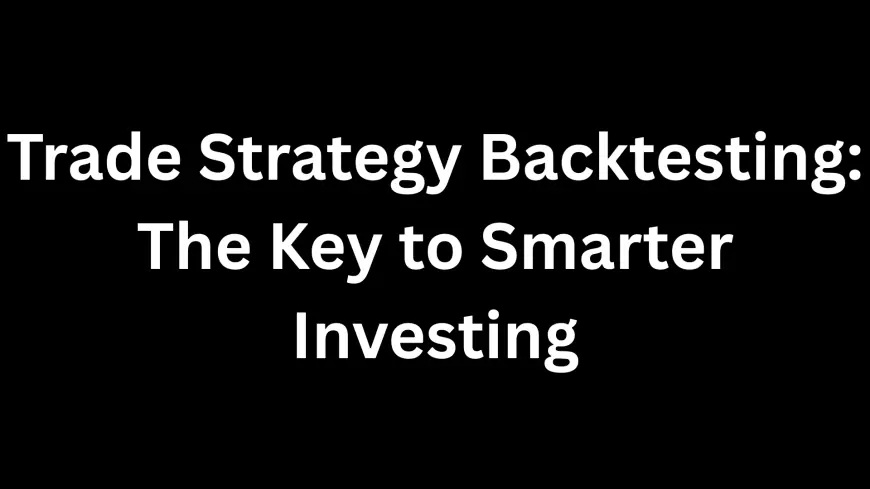Trade Strategy Backtesting: The Key to Smarter Investing
Discover how trade strategy backtesting helps traders test and refine their strategies using historical data. Learn how to avoid losses and improve accuracy in trading.

Introduction: What is Trade Strategy Backtesting?
Trade strategy backtesting is a powerful tool that allows traders to test the effectiveness of a trading strategy using historical market data. Before risking real money, backtesting offers a way to simulate how a strategy would have performed in the past. This technique is widely used by professional traders, algorithmic developers, and retail investors to validate their ideas and avoid costly mistakes.
When done correctly, trade strategy backtesting can provide strong insights into potential returns, risk levels, and trade accuracy making it an essential part of any trader's toolkit.
Why is Trade Strategy Backtesting Important?
Without backtesting, trading becomes more of a gamble. Traders often rely on assumptions or gut feelings, which can be risky. Here’s why trade strategy backtesting is crucial:
-
Risk Mitigation: By analyzing how a strategy would have worked in the past, traders can avoid repeating bad trades.
-
Confidence Building: A backtested strategy with a positive track record builds confidence when trading live.
-
Data-Driven Decisions: It removes emotions and promotes objective decision-making.
-
Strategy Optimization: Traders can tweak rules based on backtesting results to improve performance.
In short, trade strategy backtesting transforms trading from guesswork into a systematic and evidence-based process.
How Does Trade Strategy Backtesting Work?
The process of trade strategy backtesting involves these core steps:
-
Define the Strategy: Clearly outline entry and exit rules, risk management, and position sizing.
-
Select Historical Data: Use accurate and relevant market data for the timeframe you want to test.
-
Run Simulations: Apply the strategy rules on historical data using a backtesting tool or platform.
-
Analyze Results: Look at performance metrics such as profit/loss, win rate, drawdown, and risk/reward ratio.
-
Optimize & Retest: Refine the strategy and repeat the process for better outcomes.
Tools like TradingView, MetaTrader, Amibroker, and Python libraries like Backtrader or QuantConnect are popular for performing trade strategy backtesting.
Common Mistakes to Avoid in Backtesting
Although backtesting sounds straightforward, traders often fall into traps. Here are some common mistakes:
-
Overfitting: Tweaking a strategy too much to fit past data perfectly. It may fail in live trading.
-
Using Low-Quality Data: Poor or incomplete data leads to unreliable results.
-
Ignoring Slippage & Commission: These real-world costs can turn a profitable backtest into a loss-maker.
-
Small Sample Sizes: Testing on limited data might not show how a strategy performs in different market conditions.
Effective trade strategy backtesting means being honest with your data, your expectations, and your assumptions.
Types of Strategies to Backtest
Not all strategies work in all markets. Here are common types of trading strategies that can be backtested:
-
Trend-following strategies: Like moving average crossovers
-
Mean reversion strategies: Such as RSI oversold/overbought signals
-
Breakout strategies: Based on support/resistance levels or volume surges
-
News-based strategies: Involving earnings reports, economic indicators, etc.
-
Algorithmic strategies: Fully automated rules that require coding and high-frequency testing
Whichever you choose, trade strategy backtesting gives you the clarity to see what works and what doesn’t.
Benefits of Automated Backtesting Tools
Manual backtesting is possible, but time-consuming and prone to errors. That’s where automated tools shine:
-
Speed: Thousands of trades can be simulated in seconds.
-
Accuracy: Reduces human error.
-
Flexibility: Allows testing of complex rules and multiple asset classes.
-
Visualization: Graphs and performance reports make analysis easier.
If you’re serious about trading, using tools for trade strategy backtesting can save you countless hours and improve your edge in the market.
Real-World Example of Backtesting in Action
Imagine a trader wants to test a simple moving average (SMA) crossover strategy. They program the rules: buy when the 50-day SMA crosses above the 200-day SMA, and sell when the opposite happens. After running the trade strategy backtest on 5 years of historical stock data, they find:
-
Win rate: 62%
-
Average return per trade: 3.5%
-
Maximum drawdown: 10%
-
Total profit: 150%
With these results, the trader can confidently use or improve the strategy with real capital.
Conclusion: Make Trade Strategy Backtesting Your Habit
If you want to trade smarter not harder trade strategy backtesting should be part of your routine. It removes emotion, clarifies results, and helps you avoid costly mistakes. Whether you're building your own trading robot or testing a simple trend strategy, backtesting gives you the facts you need to succeed.
In today's data-rich world, not backtesting your trades is like sailing without a compass. So take advantage of the tools available, test before you invest, and let historical data guide your future profits.
What's Your Reaction?
 Like
0
Like
0
 Dislike
0
Dislike
0
 Love
0
Love
0
 Funny
0
Funny
0
 Angry
0
Angry
0
 Sad
0
Sad
0
 Wow
0
Wow
0



















































